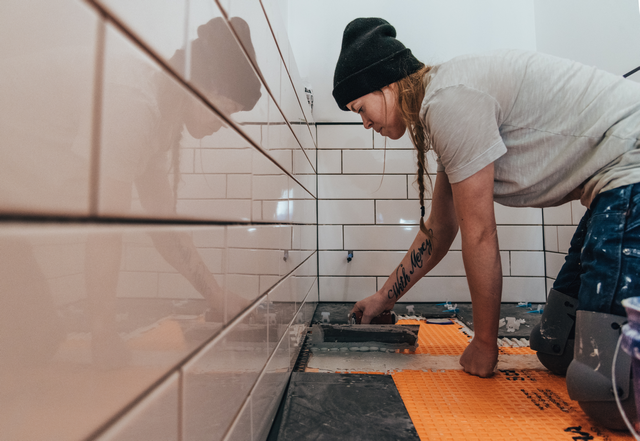Bathroom tiles are a crucial element in the design and functionality of any bathroom. Not only do they serve a practical purpose in providing a waterproof barrier for walls and floors, but they also play a significant role in the overall aesthetic appeal of the space. With a wide variety of materials, colors, patterns, and sizes available, choosing the right bathroom tiles can transform your bathroom into a stylish and functional oasis. In this comprehensive guide, we will explore the different types of bathroom tiles, their pros and cons, as well as tips on how to choose the perfect tiles for your bathroom.
Types of Bathroom Tiles
1. Ceramic Tiles
Ceramic tiles are one of the most popular choices for bathroom walls and floors. They are durable, easy to clean, and come in a wide range of colors and patterns. Ceramic tiles are also relatively affordable, making them a cost-effective option for bathroom tiles renovations. However, they can be prone to chipping and cracking if not installed properly.
2. Porcelain Tiles
Porcelain tiles are a type of ceramic tile that is fired at a higher temperature, making them denser and more durable than regular ceramic tiles. They are highly resistant to moisture and stains, making them ideal for bathroom floors and walls. Porcelain tiles come in a variety of finishes, including matte, polished, and textured, allowing for endless design possibilities.
3. Natural Stone Tiles
Natural stone tiles, such as marble, granite, limestone, and travertine, add a touch of luxury and elegance to any bathroom. Each type of natural stone has its unique characteristics and veining patterns, creating a one-of-a-kind look. While natural stone tiles are stunning, they require regular sealing to prevent water damage and staining.
4. Glass Tiles
Glass tiles are a modern and stylish option for bathroom walls and accents. They are available in a wide range of colors, shapes, and finishes, including clear, frosted, and iridescent. Glass tiles reflect light, making the bathroom appear brighter and more spacious. However, they can be slippery when wet, so they are not recommended for bathroom floors.
5. Mosaic Tiles
Mosaic tiles are small tiles that are typically arranged in intricate patterns or designs. They come in various materials, including ceramic, glass, and natural stone, and are perfect for adding visual interest to bathroom walls, floors, and backsplashes. Mosaic tiles are versatile and can be used to create unique and personalized designs in the bathroom.
Pros and Cons of Different Tile Materials
When choosing bathroom tiles, it’s essential to consider the pros and cons of each type of material to determine which is best suited for your needs.
Ceramic Tiles
- Pros: Affordable, easy to clean, wide variety of colors and patterns.
- Cons: Prone to chipping and cracking, not as durable as porcelain tiles.
Porcelain Tiles
- Pros: Highly durable, resistant to moisture and stains, versatile finishes.
- Cons: Can be more expensive than ceramic tiles, harder to cut and install.
Natural Stone Tiles
- Pros: Luxurious look, unique veining patterns, adds value to the home.
- Cons: Requires regular sealing, can be more expensive, can be slippery when wet.
Glass Tiles
- Pros: Modern and stylish, reflects light, available in various colors and finishes.
- Cons: Slippery when wet, not suitable for bathroom floors.
Mosaic Tiles
- Pros: Versatile, great for creating intricate designs, adds visual interest.
- Cons: Grout lines can be challenging to clean, more labor-intensive to install.
Tips for Choosing the Perfect Bathroom Tiles
- Consider the Size of the Space: Choose larger tiles for small bathrooms to create the illusion of more space, and smaller tiles for larger bathrooms for a more intricate look.
- Think About Maintenance: Consider how much time and effort you are willing to put into maintaining your bathroom tiles. Natural stone tiles require more maintenance than ceramic or porcelain tiles.
- Match the Tiles to Your Style: Select tiles that complement the overall style and color scheme of your bathroom. Whether you prefer a modern, traditional, or eclectic look, there are tiles to suit every taste.
- Take Lighting into Account: The lighting in your bathroom can affect the appearance of the tiles. Consider how natural and artificial light will interact with the tiles to ensure the desired effect.
- Get Creative with Patterns: Experiment with different tile patterns, such as herringbone, chevron, or basketweave, to add visual interest and personality to your bathroom.
- Consult a Professional: If you’re unsure about which tiles to choose or how to install them correctly, consult with a professional tile installer or interior designer for expert advice.
Conclusion
Bathroom tiles are an essential design element that can enhance the beauty and functionality of any bathroom. With a wide range of materials, colors, patterns, and sizes to choose from, selecting the perfect tiles for your bathroom can seem like a daunting task. By considering the pros and cons of different tile materials, following our tips for choosing the right tiles, and letting your creativity shine, you can create a stunning and personalized bathroom space that reflects your style and personality. Whether you prefer the classic elegance of natural stone tiles or the modern flair of glass tiles, there is a perfect tile out there waiting to transform your bathroom into a sanctuary of comfort and style.






